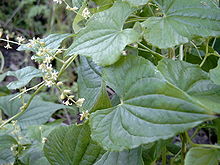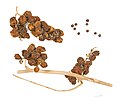Dioscorea communis
| Black bryony | |
|---|---|

| |
| Scientific classification | |
| Kingdom: | Plantae |
| Clade: | Tracheophytes |
| Clade: | Angiosperms |
| Clade: | Monocots |
| Order: | Dioscoreales |
| Family: | Dioscoreaceae |
| Genus: | Dioscorea |
| Species: | D. communis
|
| Binomial name | |
| Dioscorea communis (L.) Caddick & Wilkin
| |
| Synonyms[1] | |
| |
Dioscorea communis or Tamus communis is a species of flowering plant in the yam family Dioscoreaceae and is commonly known as black bryony, lady's-seal or black bindweed.[2]
Description
It is a climbing
dioecious, with separate male and female plants. The flowers are individually inconspicuous, greenish-yellow, 3–6 mm diameter, with six petals; the male flowers produced in slender 5–10 cm racemes, the female flowers in shorter clusters. The fruit is a bright red berry, 1 cm diameter. Its fairly large tuber is, like the rest of the plant, poisonous
.
Distribution
Dioscorea communis is native and widespread throughout southern and central Europe, northwest Africa and western Asia, from Ireland to the Canary Islands, east to Iran and Crimea.[1][4][5][6][7][8]
Habitat
Dioscorea communis is a typical plant of the forest understory, from the sea to the mountains, usually in dense woods, but it can also be found in meadows and hedges.
Uses
All components of the black bryony plant, including the tubers, are poisonous due to
blisters
.
Studies have isolated
rhizomes, which may contribute to skin irritation and contact dermatitis associated with black bryony.[9]
Chemistry
The rhizome contains
7-hydroxy-2,3,4,8-tetramethoxyphenanthrene, 2,3,4-trimethoxy-7,8-methylenedioxyphenanthrene, 3-hydroxy-2,4,-dimethoxy-7,8-methylenedioxyphenanthrene, 2-hydroxy-3,5,7-trimethoxyphenanthrene and 2-hydroxy-3,5,7-trimethoxy-9,10-dihydrophenanthrene).[10]
Gallery
-
Illustration from Flora von Deutschland, Österreich und der Schweiz 1885
-
Plant of Dioscorea communis
-
Close-up of fruits of Dioscorea communis
-
Fruits and seeds
-
Young shoots - edible part of black bryony
References
Wikimedia Commons has media related to Dioscorea communis.
Wikispecies has information related to Dioscorea communis.
- ^ a b Kew World Checklist of Selected Plant Families.
- ^ "Dioscorea communis". Germplasm Resources Information Network. Agricultural Research Service, United States Department of Agriculture. Retrieved 31 March 2015.
- ISBN 978-1408179505.
- ^ Altervista Flora Italiana, Tamaro, Dioscorea communis (L.) Caddick & Wilkin includes photos plus European distribution map
- ^ Govaerts, R., Wilkin, P. & Saunders, R.M.K. (2007). World Checklist of Dioscoreales. Yams and their allies: 1-65. The Board of Trustees of the Royal Botanic Gardens, Kew.
- ^ Dobignard, D. & Chatelain, C. (2010). Index synonymique de la flore d'Afrique du nord 1: 1-455. Éditions des conservatoire et jardin botaniques, Genève.
- ISBN 0-340-40170-2.
- ^ Flora Europaea: Tamus communis distribution Royal Botanic Garden Edinburgh, Inverleith Row, Edinburgh, EH3 5LR, United Kingdom(2008).
- ^ "Black bryony (Tamus communis, Dioscorea communis) - Mango's Market".
- PMID 17166530.





